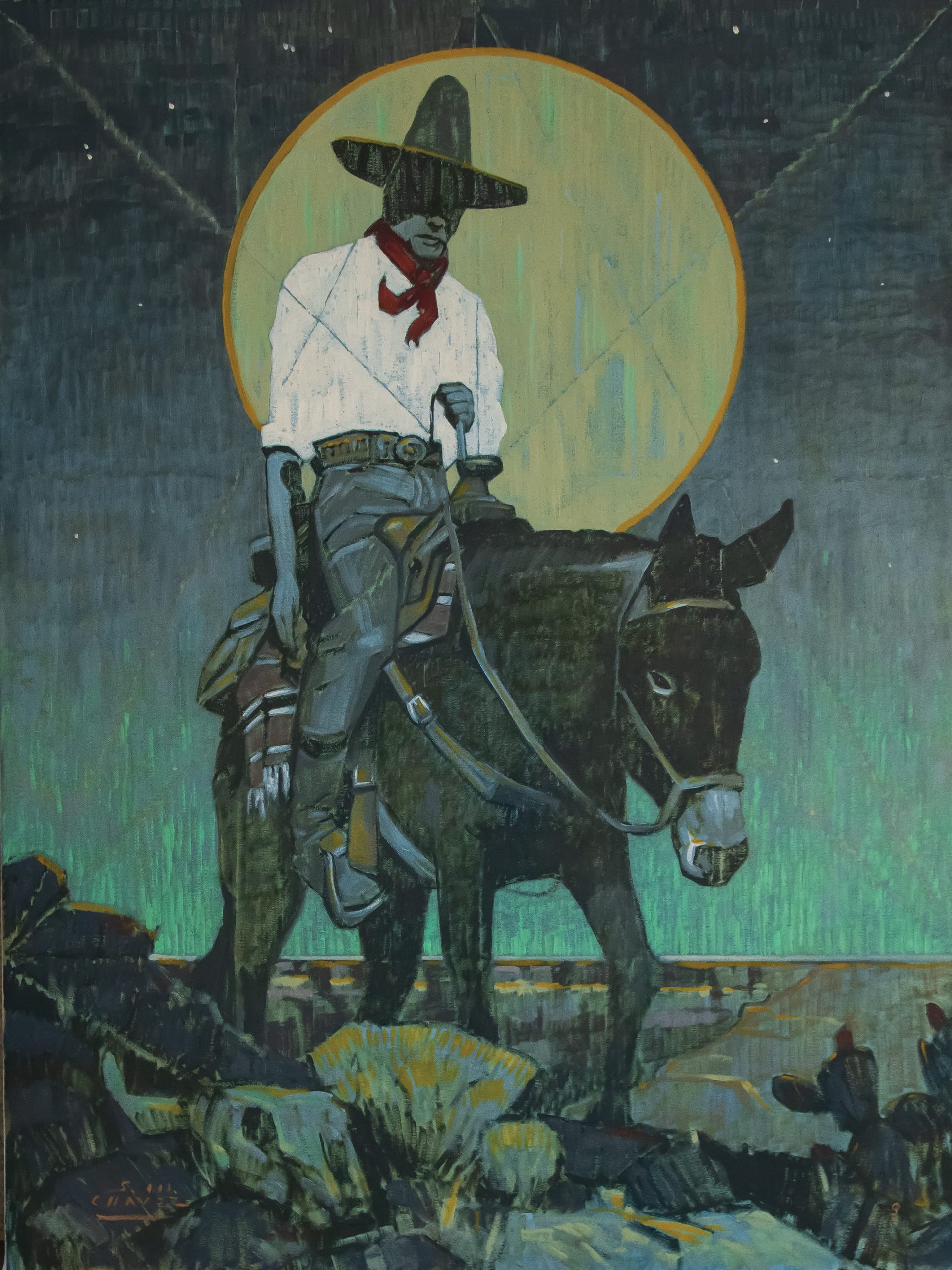
04 Jul ¡Viva el Vaquero!
The young vaquero sits on a ramshackle wooden stool, his back against a fencepost, his eyes shaded by the brim of his sombrero, his head and shoulders slouched as he closely admires his prized new six-shooter. Strewn on the ground are the cartridge casings of the bullets he’s just fired in the process of getting acquainted with the gun. It doesn’t really matter what the target was — maybe another fencepost or bottles and tin cans propped up on a railing that made a satisfying “plink” when his aim was true. What matters to him is the firearm itself and the act of familiarizing himself with an essential tool in a still untamed land.
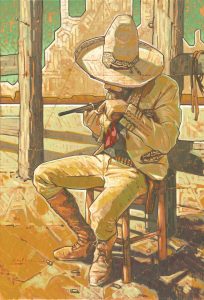
Plinker | Oil on Canvas | 40 x 20 inches
Charmingly entitled Plinker, the painting not only effectively and beautifully captures a candid moment for one of the myriad Mexican-American cowboys who played a vital role in the setting of the Old West, but it also marks a significant career milestone for the rapidly rising new Western art star who painted it. Along with another recent work, Into the Realm, the painting represents the debut of Sean Michael Chavez in one of the most prestigious events in the contemporary Western art world: the 2025 edition of the Prix de West Invitational Art Exhibit & Sale, which opened on June 6 and continues through August 3 at the National Cowboy & Western Heritage Museum in Oklahoma City, Oklahoma. (This was the second year he’d applied to be in the show, and he’s had paintings in the museum’s Small Works, Great Wonders holiday show for the past five years.)
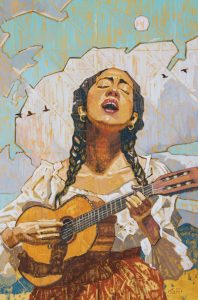
Duet (Panel 1) | Oil on Canvas | 36 x 24 inches
Plinker also stands as a prime example of the rare combination of innate talent, deep knowledge, and dedicated work that has fueled Chavez’s career. Consider, for example, Chavez’s enthusiasm for one particular detail of the painting that may go unnoticed at first; in fact, it adds to the depth of satisfaction the painting offers. “You see those bullet shells around his feet? They’re my little reference to a painting of a man and woman dancing by Impressionist master Pierre-Auguste Renoir called Dance at Bougival, which made such an impression on me when I used to study it at the Museum of Fine Arts when I lived in Boston. Get up close to that Renoir painting, and you notice a cigarette butt at the man’s feet. Who the heck is going to put that in a romantic painting of a couple dancing? But that’s the kind of simple little detail that makes it all come together.”
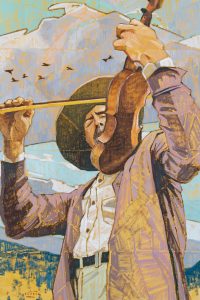
Duet (Panel 2) | Oil on Canvas | 36 x 24 inches
Chavez has been paying attention to the details of art for most of his life, gradually paving the way for the success he now enjoys. Born in Albuquerque, New Mexico, in 1971, the only child of an Irish-American mother and a New Mexican father, he grew up obsessed with art, including drawing faithful renditions of Marvel superheroes. “In elementary school,” he recalls, “I was the kid who would get in trouble for drawing rather than doing my math. Several of my drawings were torn up by my teachers, and I would come home crying and just redraw them.” By the time he’d gone on to Highland High School, though, his artistry was rewarded with special after-school classes not only in painting but also computer animation using early Macintoshes; he also made music — playing guitar, bass, and drums — in the school’s elite salsa band.
Still, Chavez began his higher education pursuing not art but English literature at the University of New Mexico. He left those studies, though, and eventually wound up traveling cross-country in his old VW Beetle to visit friends in Boston, where he supported himself working as a manager at the Urban Outfitters store in Harvard Square. “I was painting quite a bit then,” he says of efforts that even led to a few small shows in local cafes, “but I wasn’t making a living as an artist.” What he was doing, however, was educating his artist’s eye during his year and a half there with visits two, three, and sometimes even four times a week to the exceptional Museum of Fine Arts, becoming such a regular that “the staff and security recognized me and would pretty much let me run freely just about anywhere I wanted.”
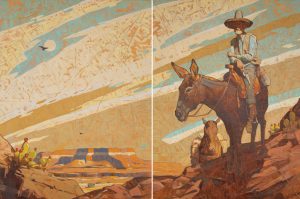
The Divide (Panels 1 and 2) | Oil on Canvas | 40 x 60 inches
In addition to Renoir’s dancers, he developed a special fondness for the works of master portraitist John Singer Sargent — not just the extraordinary large-scale likenesses he captured of Gilded Age society on both sides of the Atlantic but also the delight he took in using small touches of pure white oil paint right out of the tube to give “pops of light” to an almost-finished canvas. (You can see just such a subtle highlight on the rider’s shoulder in Chavez’s painting Into the Realm.)
On a visit to the Metropolitan Museum in New York City during that time, Chavez also got to savor up-close looks at paintings by Vincent van Gogh, learning lessons he also applies to his work today. “The first time I saw his work firsthand, I was shocked by how much of his paintings were actually raw canvas with brushstrokes that weren’t even touching each other. I still do that in my own work.”
After a brief period living in San Francisco and trying to build an art career, Chavez returned home to Albuquerque in the mid-1990s and buckled down to study at a local graphic arts college. He excelled there and went on to build a highly successful career as a graphic designer, producing a wide range of work that included a performing arts magazine, branding, marketing, high-end package design, and illustration.
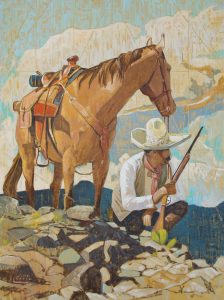
Rebeldes Look | Oil on Canvas | 40 x 30 inches
But those earliest aspirations never fully left Chavez, and his passion was rekindled during a visit to Santa Fe with his mother and grandmother around 13 years ago. “Walking up and down Canyon Road with them, I remembered doing that as a boy and dreaming of being an artist,” he says. He began painting again in earnest. Most importantly, while exploring his own New Mexican heritage and the role of vaqueros — literally, “cowboys” in Spanish — in the history of the West, he realized that he’d found a largely untapped subject for his own creativity.
He also began applying the savviness he’d gained through his marketing career while building an initial body of work — not in any cynically calculated way but rather to plan the journey of his own creative explorations. By way of example, he offers the fact that “my earlier paintings were more subdued in their tones,” sometimes almost resembling old sepia images, which left room going forward “for my color palette to be able to blossom, and then for me to be able to bounce back and forth between my palettes.”
Early on, he also began planning his compositions using a geometric grid that he allowed to show through the paint in places, which may remind some viewers of the circle-and-square lines Leonardo da Vinci used in his famous drawing Vitruvian Man to demonstrate the divine proportions of the human figure. “I don’t really need a grid to design a painting,” he adds, noting that he sees them as “an intellectual practice” akin to the structure of a musical composition and the interpretive performances by the musicians who play it. “Beauty comes in the way you break those patterns.”
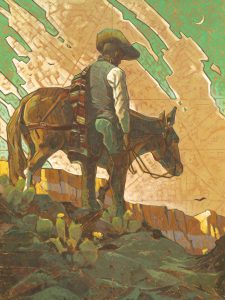
Into the Realm | Oil on Canvas | 40 x 20 inches
In preparation for launching his search for a top gallery, in 2019, Chavez began following some of those he admired on Facebook and sent a “friend” request to Carlos Acosta, co-owner of Acosta Strong Fine Art in Santa Fe. “Before accepting,” Acosta recalls, “I looked at his page, realized he was an artist, and thought, oh my God, your work is wonderful! So, I invited him to the gallery to show me his paintings in person.” Chavez brought in seven or eight paintings the following week. “He had such a great presence and so much potential,” Acosta continues. “And I thought, man, I can work with this guy!” Acosta signed him on, and his paintings began selling the following day. Regular sold-out shows at the gallery followed. Chavez’s latest at Acosta Strong, Into the Realm, will present more than a dozen new works from August 4 to 21, with an opening reception on the 8th.
As he does with each new show, Chavez likes “to throw Carlos and collectors a curveball, presenting something different.” This time around, he’s presenting several diptychs including female figures, most notably in the pair of paintings titled Duet. One panel depicts a young guitarrista strumming and singing, and the other show a man playing the fiddle; above their heads, birds appear against the clouds like musical notes taking flight.
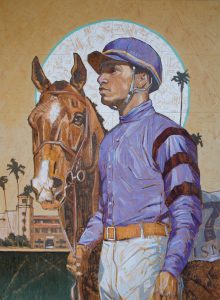
Lucky Sevens | Oil on Raymar Panel | 40 x 30 inches
In addition to the show at Acosta Strong Gallery, Chavez will participate in Far West, a group show featuring some three dozen contemporary Western artists organized by Mark Maggiori and Petecia Le Fawnhawk, on September 12 and 13 at Preacher Gallery in Austin, Texas.
This autumn, Chavez will further extend his creative range with the debut of a prestigious commission as the official artist of this year’s Breeders’ Cup World Championship, recognized as the grand finale of the Thoroughbred horse racing season. Held on October 31 and November 1 at the historic Del Mar Thoroughbred Club north of San Diego, California, the event will gain a special artistic aura from Chavez’s two grand paintings, which will appear on tickets, posters, programs, and in other official forms. The original works will be auctioned off in Lexington, Kentucky, to raise money for charities supporting the Thoroughbred industry.
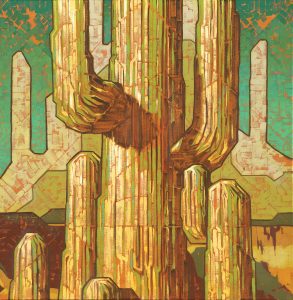
Desert Sentinel | Oil on Canvas | 30 x 30 inches
Though their subject matter may be different from Chavez’s more familiar works, the two paintings speak to the latest evolution in the artist’s palette and compositional style. No one could mistake them for the creations of anybody else.
Indeed, like the airborne birds in Duet or a racehorse barreling down the stretch, Sean Michael Chavez’s career has undeniably taken on an irresistible momentum of its own. “I have the impression that sometimes people think Western art is an old subject. But with the help of artists like myself and many of my peers, it is very much contemporary and very much alive.”






No Comments